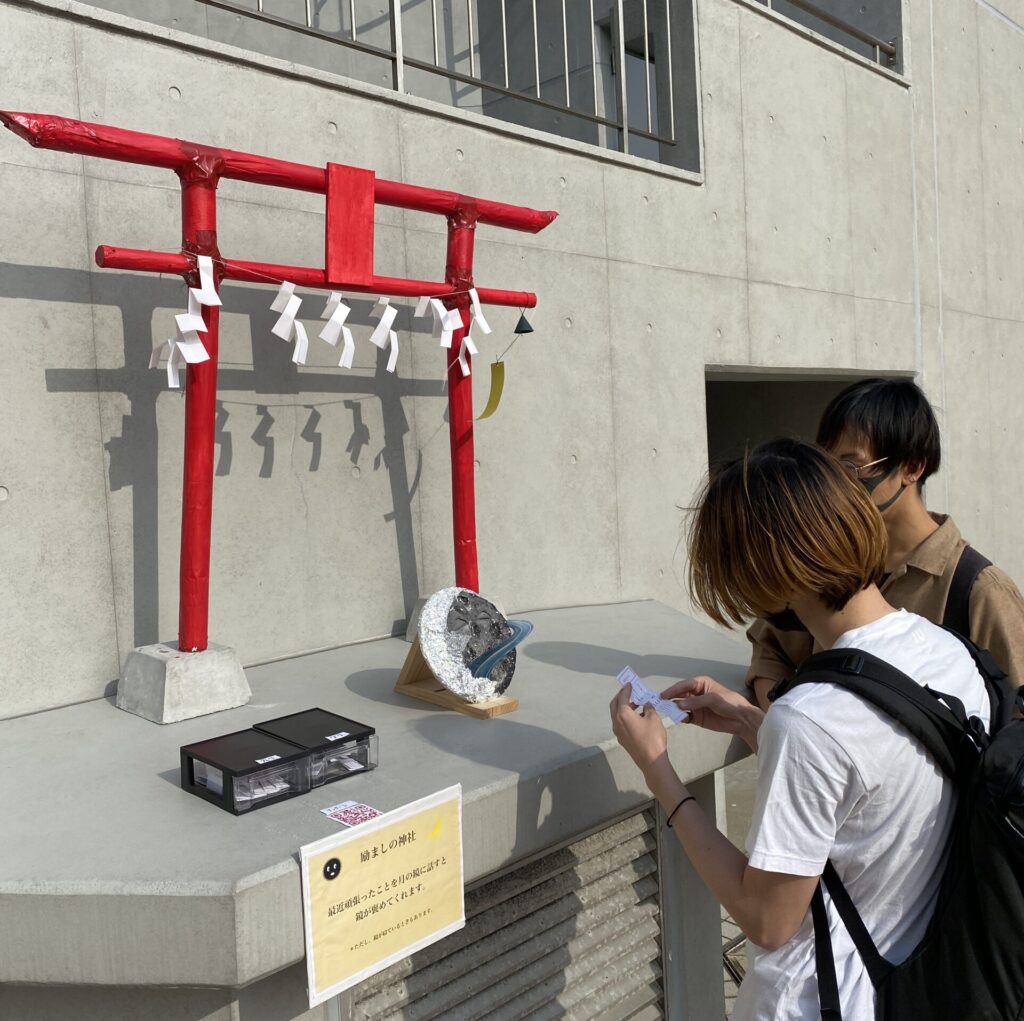Dialogical Healing Installation Art (DHIA)
*Dialogical Healing Installation Art (DHIA) is just an idea and thought, there is a lack of evidence. The purpose of this writing is to push forward the idea from a design and art perspective for mental health and well-being. If you are curious about the concept, feel free to reach out and discuss it.
1. Definition of DHIA
Dialogical Healing Installation Art (DHIA), coined by the author, aims to foster healing conversations through installation artwork and functions as preventative mental care. They have the characteristics of installation art, particularly focusing on the concepts of time and space. It can be a cultural construction strongly associated with the community context and participants, such as religion, area, gender, and mental model. Artworks facilitate a specific conversation by designing the environment and utilizing people’s imagination.

2. What is Installation Art
Installation Art primarily focuses on transforming institutional and public spaces. Tate defines it as a large-scale, mixed-media artwork tailored for a specific location or time. It should utilize and be interconnected with its environment, surpassing traditional gallery constraints. Faye Ran emphasizes the importance of “space” and “time” in Installation Art. “Space” is multifaceted and varies across cultures, encompassing visual, sound, tactile, and kinesthetic senses. While traditional art forms like paintings capture a timeless essence, Installation Art immerses participants in the present, making them aware of time and space. It’s essential to distinguish installation art from public and site-specific art. Public art is community-focused, placed in public locations. In contrast, site-specific art is deeply tied to its location, losing significance if moved. Installation art is versatile: it’s three-dimensional, can be public, site-specific, movable, temporary, or permanent, but always provides a unique, ephemeral experience for its audience.
3. Preventative Mental Care
The World Health Organization (WHO) reports that one in eight people globally suffer from mental disorders like anxiety, depression, PTSD, and more. The COVID-19 pandemic in 2020 caused a significant rise in anxiety and depressive disorders, with increases of 26% and 28% respectively. Loneliness is a major concern, being linked to mental health issues, and research shows that over 33% of individuals over 45 feel lonely, with 25% of those over 65 being socially isolated. Therefore, it’s vital to tackle mental disorders early on. There are three stages of prevention in healthcare: primary (preventing illnesses before they become severe), secondary (early intervention), and tertiary (improving recovery and reducing risks). Despite symptoms being below diagnostic thresholds, they can lead to serious mental conditions. As mental health deteriorates, recovery becomes more challenging, emphasizing the importance of preventative mental care.
4. What is the example of DHIA?
Talking Tree
This artwork, exhibited at a university campus and shrine in Japan, utilizes a participatory approach to encourage engagement with a large camphor tree on the campus. The artwork aims to facilitate a realistic dialogue between participants and the tree, in order to reveal emotions related to the pandemic context. Through this communication, more than one hundred participants were able to engage in an interactive experience with the tree. The author talked to the participants as a camphor tree. This artwork serves as an example of how art, design, and technology can elicit emotional responses and facilitate deeper connections with the natural environment.

Encourage Shrine
This artwork, exhibited at a university campus in Japan, utilizes a participatory approach to encourage engagement in dialogue with an art object “Mirror of Moon.” If the participants talk about their efforts or what happed recently, “Mirror of Moon” is supposed to listen to their voice and give a compliment to them. The artwork aims to encourage the students and faculty in a campus and rejuvenate campus community by creative practice

5. Why is DHIA beneficial for preventative mental health?
DIHA (assuming you meant DHIA) is considered beneficial for preventative mental care primarily due to its alignment with the core essence of psychotherapy: creating a safe and conducive environment for mental and emotional expression. The design of DHIA, or Digital Health Installation Art, facilitates healing conversations and experiences by intertwining the physical environment with psychological safety. Through meticulously created installation art, participants can engage in healing interactions even in the absence of a conventional therapist or traditional psychotherapy setting. The art installations are deliberately designed to evoke open communication, imaginative experiences, and emotional releases, which are pivotal in fostering mental wellness and preventing the escalation of mental health issues. Thus, the synergy between the therapeutic essence of safe environmental design and the psychologically affirmative experiences crafted by DHIA underpins its value in preventative mental care.
6. Why does DHIA matter now?
Mental care faces challenges as many people with mental disorders avoid seeking help due to stigma and a lack of awareness. With the rise of technology, our communication habits have shifted, leading to the development of AI-driven mental health apps for immediate access. While beneficial, excessive use of these tools has been linked to smartphone addiction and depression. DHIA offers a valuable alternative with its accessible mental care that not only encourages healing conversations but also helps rejuvenate communities. As the role of AI grows in the workforce, the emphasis is shifting towards more personalized, “Meaningful Art” that merges self-expression and empathy. This approach, influenced by design principles, might generate varying opinions about its artistic attributes. Thus, DHIA epitomizes the blend of design and art.
References
AbdulRaheem, Y. (2023). Unveiling the Significance and Challenges of Integrating Prevention Levels in Healthcare Practice. Journal of Primary Care & Community Health, 14, 21501319231186500. https://doi.org/10.1177/21501319231186500
Alhassan, A. A., Alqadhib, E. M., Taha, N. W., Alahmari, R. A., Salam, M., & Almutairi, A. F. (2018). The relationship between addiction to smartphone usage and depression among adults: A cross sectional study. BMC Psychiatry, 18(1), 148. https://doi.org/10.1186/s12888-018-1745-4
Committee on the Health and Medical Dimensions of Social Isolation and Loneliness in Older Adults, Board on Health Sciences Policy, Board on Behavioral, Cognitive, and Sensory Sciences, Health and Medicine Division, Division of Behavioral and Social Sciences and Education, & National Academies of Sciences, Engineering, and Medicine. (2020). Social Isolation and Loneliness in Older Adults: Opportunities for the Health Care System (p. 25663). National Academies Press. https://doi.org/10.17226/25663
Corey, G. (2022). STUDENT MANUAL FOR THEORY AND PRACTICE OF COUNSELING AND PSYCHOTHERAPY (10th ed.). Cengage Learning.
DeRubeis, R. J., Gelfand, L. A., German, R. E., Fournier, J. C., & Forand, N. R. (2014). Understanding processes of change: How some patients reveal more than others – and some groups of therapists less – about what matters in psychotherapy. Psychotherapy Research : Journal of the Society for Psychotherapy Research, 24(3), 419–428. https://doi.org/10.1080/10503307.2013.838654
Dray, J., Bowman, J., Campbell, E., Freund, M., Wolfenden, L., Hodder, R. K., McElwaine, K., Tremain, D., Bartlem, K., Bailey, J., Small, T., Palazzi, K., Oldmeadow, C., & Wiggers, J. (2017). Systematic Review of Universal Resilience-Focused Interventions Targeting Child and Adolescent Mental Health in the School Setting. Journal of the American Academy of Child & Adolescent Psychiatry, 56(10), 813–824. https://doi.org/10.1016/j.jaac.2017.07.780
Gibson, James. J. (1979). The Ecological Approach to Visual Perception. Boston: Houghton Mifflin.
Global Health Data Exchange (GHDx). (2023). Institute for Health Metrics and Evaluation. https://vizhub.healthdata.org/gbd-results
Gulliver, A., Griffiths, K. M., & Christensen, H. (2010). Perceived barriers and facilitators to mental health help-seeking in young people: A systematic review. BMC Psychiatry, 10(1), 113. https://doi.org/10.1186/1471-244X-10-113
Joinson, A. N. (2001). Self-disclosure in computer-mediated communication: The role of self-awareness and visual anonymity. European Journal of Social Psychology, 31(2), 177–192. https://doi.org/10.1002/ejsp.36
Karsten, J., Hartman, C. A., Smit, J. H., Zitman, F. G., Beekman, A. T. F., Cuijpers, P., van der Does, A. J. W., Ormel, J., Nolen, W. A., & Penninx, B. W. J. H. (2011). Psychiatric history and subthreshold symptoms as predictors of the occurrence of depressive or anxiety disorder within 2 years. The British Journal of Psychiatry: The Journal of Mental Science, 198(3), 206–212. https://doi.org/10.1192/bjp.bp.110.080572
Lambert, M. J. (1992). Psychotherapy outcome research: Implications for integrative and eclectical therapists. Basic Books.
Mann, F., Wang, J., Pearce, E., Ma, R., Schlief, M., Lloyd-Evans, B., Ikhtabi, S., & Johnson, S. (2022). Loneliness and the onset of new mental health problems in the general population. Social Psychiatry and Psychiatric Epidemiology, 57(11), 2161–2178. https://doi.org/10.1007/s00127-022-02261-7
Mesman, E., Vreeker, A., & Hillegers, M. (2021). Resilience and mental health in children and adolescents: An update of the recent literature and future directions. Current Opinion in Psychiatry, 34(6), 586–592. https://doi.org/10.1097/YCO.0000000000000741
Min, J.-A., Lee, C.-U., & Lee, C. (2013). Mental Health Promotion and Illness Prevention: A Challenge for Psychiatrists. Psychiatry Investigation, 10(4), 307. https://doi.org/10.4306/pi.2013.10.4.307
Minamii, Y., & Kim, D. (2022). Black Rotary Telephone Art Exhibit Entitled “Talking Tree.” International Journal of Asia Digital Art and Design Association, 26(4), 55–64. https://doi.org/10.20668/adada.26.4_55
Minamii, Y., Mi, S., & Zhang, Y. (2022). Art Exhibit Entitled “Shrine of Encouragement” -Practice and Proposal for Social Emotional Learning at University. Design Research.
My Wind Phone. (n.d.). My Wind Phone. Retrieved August 30, 2023, from https://www.mywindphone.com
Norman, D. A. (1988). The psychology of everyday things. New York: Basic Books.
Ran, F. (2009). A history of installation art and the development of new art forms: Technology and the hermeneutics of time and space in modern and postmodern art from cubism to installation. Peter Lang Publishing, Inc., New York.
Rosenthal, M. (2003). Understanding Installation Art From Duchamp to Holzer. Prestel Munich – Berlin・London・New York.
Suderburg, E. (2000). Space, Site, Intervention: Situating Installation Art. U of Minnesota Press.
Tate. (n.d.-a). Installation art. Tate. Retrieved August 30, 2023, from https://www.tate.org.uk/art/art-terms/i/installation-art
Tate. (n.d.-b). Site-specific. Tate. Retrieved August 30, 2023, from https://www.tate.org.uk/art/art-terms/s/site-specific
What is public art? (n.d.). Association for Public Art. Retrieved August 30, 2023, from https://www.associationforpublicart.org/what-is-public-art/
World Health Organization. (2022). Mental Health and COVID-19: Early evidence of the pandemic’s impact.
Wu, G., Feder, A., Cohen, H., Kim, J., Calderon, S., Charney, D., & Mathé, A. (2013). Understanding resilience. Frontiers in Behavioral Neuroscience, 7. https://www.frontiersin.org/articles/10.3389/fnbeh.2013.00010